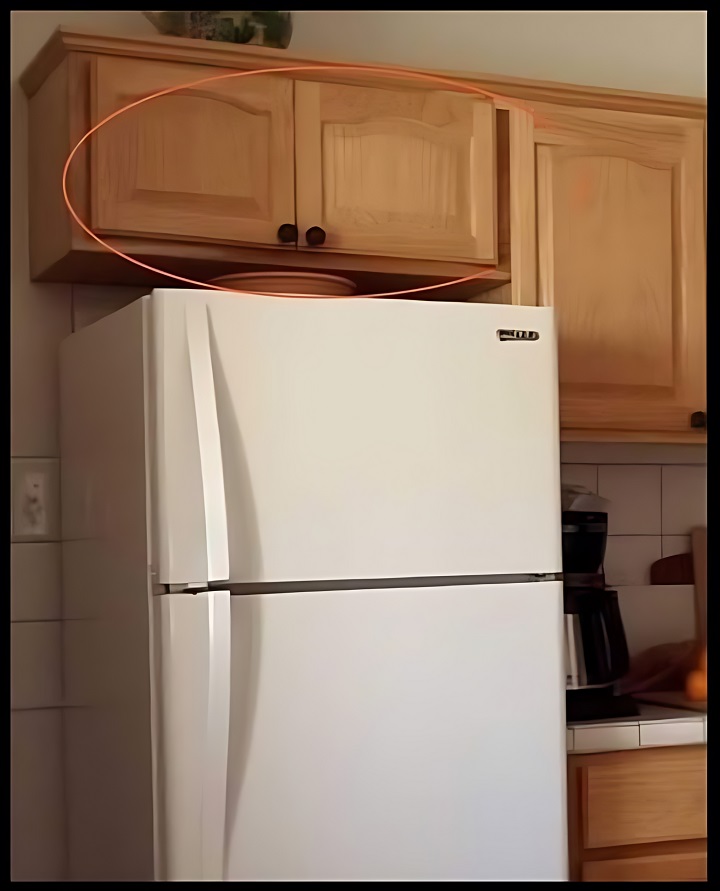A tidy home isn’t just a preference for me—it’s the foundation of how I function. Clutter distracts me, steals my focus, and saps my energy. That’s why even my refrigerator is organized with intention,
and yes, that includes the small, often forgotten cupboards above it. When I was a kid, I never thought much about cleanliness or order. Like most children, I’d leave a trail of toys, school supplies,
and snack wrappers in my wake. But my mother—graceful, meticulous, and somehow always two steps ahead—maintained a home that looked like it belonged in a magazine spread. Everything had a place, every corner had purpose. Over time, her habits became lessons, and her lessons became second nature to me.
One of the things I remember most clearly was how she used every inch of our kitchen, especially those odd little cabinets perched above the refrigerator. At first glance, they seem useless—awkward to reach,
easy to forget, and often a dusty no-man’s land. But to my mother, they were an opportunity. She’d pull over her sturdy little stool, open those tiny doors with a sense of purpose, and tuck away everything that didn’t belong on the daily-use shelf.
She taught me to use those cabinets smartly. First, appliances that don’t see the light of day often—like the food processor used only for holiday stuffing or the blender reserved for weekend smoothies—go up top.
If it’s not part of your everyday rhythm, it doesn’t need prime kitchen real estate. Then there’s the pantry overflow: canned vegetables, beans, broths, jars of olives and marinara—items with long shelf lives that don’t mind a little solitude.

She stored baking essentials like extra bags of flour, sugar, cocoa powder, and those seasonal cookie cutters you only touch once a year. Next came the cookbooks. The ones too pretty to part with, filled with recipes she never had time to try but couldn’t bear to throw out.
Tucked neatly on their sides or upright like miniature treasure chests, they lived there quietly, waiting for a snowy day or a burst of culinary inspiration. She even used small tiered racks to store backup spices and pantry goods,
each bottle labeled, every row perfectly visible. A system that once looked like overkill to me now feels like sanity in a jar.
Sometimes she’d buy kitchen towels in bulk—on sale, of course—and keep them folded up there, untouched and clean, ready for when the drawer stash wore thin. And perhaps most cleverly, she kept our fine china up there too.
Not the everyday plates, but the beautiful, delicate dishes used only at Thanksgiving or when company came. The ones she didn’t want our little fingers breaking during hide-and-seek or impromptu sword fights with wooden spoons.
Of course, there are rules. She always warned me: don’t overload them. Use a solid stool, never climb precariously. Don’t store anything heavy. Be mindful—heat rises, and fridges aren’t exactly cool on top.
Some items, like chocolate or certain oils, don’t belong up there because of the temperature fluctuation. But if you’re intentional, thoughtful, and organized, those high little cupboards become something magical—a hidden gem in your kitchen, a quiet place where order lives and chaos takes a break.
Today, when I open my own over-fridge cupboards, I smile. My blender sits tucked in beside a stack of cake tins. A row of canned chickpeas and coconut milk lines the back. A sealed bag of pastry flour and a rarely-used cookbook titled “Rustic French Cooking” rest undisturbed, waiting.
It’s not about perfection. It’s about peace. And in a world that moves too fast, even something as small as a neat cupboard can bring clarity to a chaotic day.



